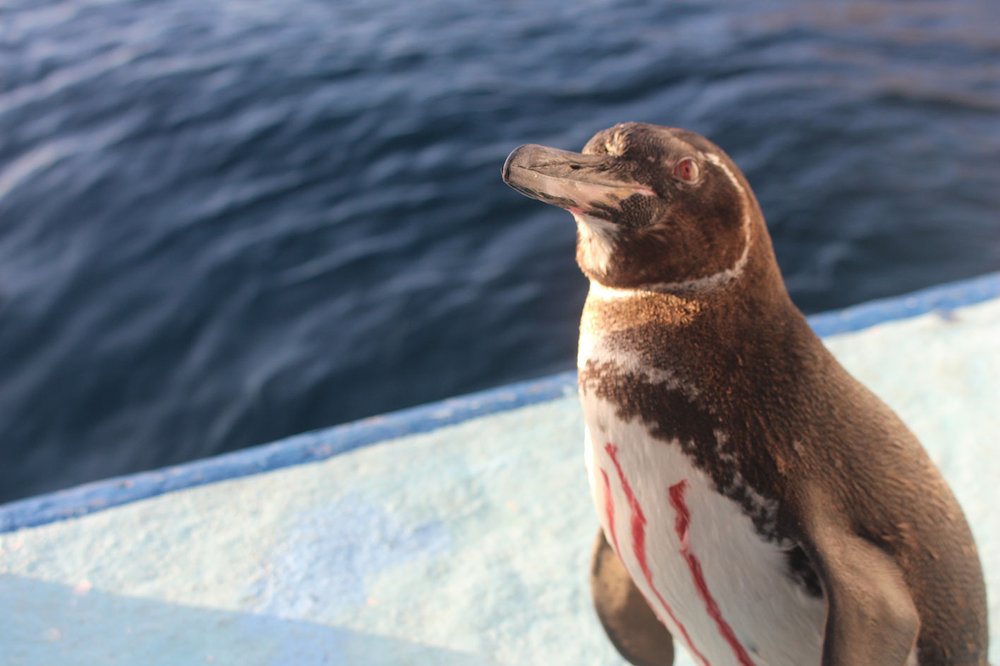--Press Release-- The age of the oldest penguin in the Galapagos Island has been recently discovered by scientists at the Charles Darwin Foundation, who were working with the Galapagos National Park Directorate on Isabella Island. The penguins age is 17.7 years old. This female penguin was first captured in 2004 when she was around 2 years old, we know she was this age as plumage is very characteristic of juvenile penguins. In 2016 she was recaptured, and with this recapture all previously date on the Galapagos penguin was refuted, because it was thought that this endemic species only reached 11 years of age. These new findings about their life expectancy allow scientists to document the life cycle of this species and suggest new conservation strategies (Jiménez-Uzcátegui & Vargas 2019).

Spheniscus Mendiculus is the only species of penguin that lives in tropical areas, above the equator line. The presence of this species in the Galapagos has only been made possible by the complex system of cold sea currents, that enrich the archipelago waters. It is for this reason; penguins depend heavily on areas that have cold currents because there is more food. It goes without saying that penguins are very sensitive to changes in water temperature.
El Niño Southern Oscillation (ENOS), also known as El Niño event, effects all life on the Galapagos Islands. In 1982 and 1983 the strongest El Niño phenomenon of the century was recorded in the Galapagos, followed by another similar event in 1997 and 1998. In these two El Niño events it is estimated that the penguin population was reduced by approximately 60% (Vargas et al, 2007) in relation to the population registered in the year before El Niño. Today, although the population numbers of penguins in the Galapagos have increased, it has not yet increased to the numbers lost in the 1970s.
This species faces other major threats affecting its long-term conservation, such as invasive species (e.g. rats& cats) that feed on their chicks, pathogens, parasites and pollution that affect their health, and human interaction caused by some drifting fishing nets that can lead to them becoming in-tagged and trapped.
The long-term research of these birds by the CDF, contribute to a better understanding of their current states and will allow the CDF to give guidelines to support conservation actions taken to ensure the conservation of this species endemic to the Galapagos.
How do you study the population status of these birds?
Animal population status is a primary research technique within Conservation Biology. One of the methods used to conduct this study with penguins in the Galapagos is the "population monitoring based on the 'capture-recapture'. In the case of the marine bird monitoring program such as the Galapagos Penguin Spheniscus Mendiculus, a project led by scientist Gustavo Jiménez-Uzcátegui, it has been a research technique carried out over the last ten years.

This study aims to capture and mark penguins, for two seasons in the year (dry and wet). Each captured individual is placed with a microchip also known as a PIT tag (Passive Integrated Transporter). From the moment the chip is activated the penguin movement and data can be tracked for serval years, until its recapture.
The study is then carried out and thus the population status of the species is evaluated, by observing the number of new individuals that are marked in each season and the number of individuals recaptured. An additional component of the research focuses on the medical, clinical and ecological component, which seek to understand the threats as far as pathogens, parasites and contaminants are concerned.
During population monitoring of penguins carried out from 2001 to 2018, a total of 1,822 individuals have been tagged, of which 1,011 were recaptured. Of these, older individuals who are 14, 13 and 12 years old respectively were captured for the first time when they were chicks in 2004 and 2005. The Galapagos penguin, demonstrates parental care of its chicks. What this means is that after a chick is born the parents look after it until the chick becomes independent. Penguins have slow breeding rates, but they do live for longer- scientist believe this is a breeding strategy that ensures their survival.

Their populations in the wild can be fluctuating, not to mention small, fewer than 2000 individuals, which continue to be threatened put them at serious risk of extinction according to the IUCN (International Union for Conservation of Nature). For this reason, it is important to know the maximum age that the Galapagos penguin can reach. This knowledge helps scientists give advice to authorities, tourist boards, design conservation strategies and ensure their survival.
Referencies:
Jiménez-Uzcátegui, G., & Vargas, F. H. 2019. Maximum observed ages of Galapagos Penguins. Marine Ornithology 243-246.
Vargas, F. H., Lacy, R. C., Johnson, P. J., Steinfurth, A., Crawford, R. J., Boersma, P. D., & Macdonald, D. W. (2007). Modelling the effect of El Niño on the persistence of small populations: The Galápagos penguin as a case study. Biological Conservation, 137(1), 138-148.





